Poison hemlock is a beautiful plant… that’s also lethal! The unseasonably wet winter and spring – followed by flooding in many regions of the United States, has caused this deadly toxic and invasive plant to pop up all around the country.
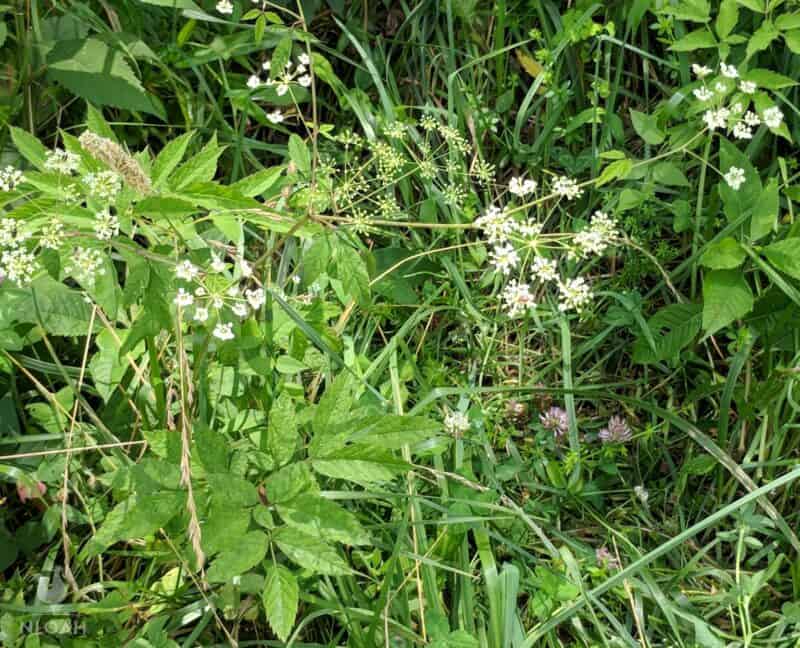
Once the shock of spotting it on your land wears off, then your real problem begins: getting rid of it.
Poison hemlock goes by many names, names such as California fern, poison parsley, or deadly hemlock.
Hemlock is nearly a dead ringer (pun intended) for yarrow and Queen Anne’s Lace – wild carrots. The similarity between both the flowers and the leaves between these beneficial weeds and poison hemlock is why novice foragers are staunchly discouraged from plucking them from the fields and forest edges where they thrive.
What Are Poison Hemlock’s Look-alikes?
Poison hemlock is easy to get confused with its lookalikes, namely Queen Anne’s lace, cow parsley, Angelica, parsnips (cow, wild, and water), and yarrow.
There are, however, obvious differences between all these plants, which we’ll talk about below.
Can Poison Hemlock Be Deadly?
Yes, poison hemlock can be deadly, and it is highly recommended you stay away from it. You also shouldn’t feed it to animals. You could see the symptoms appear 30 minutes after you ingest it. All of the parts of poison hemlock are poisonous. More on that here.
This toxic weed is not native to the United States. It is believed to have been brought here from early Europeans to use as an ornamental plant. In addition to Europe, poison hemlock also grows naturally throughout Asia.
Poison Hemlock Facts
- This toxic plant causes significant economic loss for farmers, ranches, and homesteaders annually – especially in western states where it more commonly grows. Ingestion of poison hemlock can cause death to the animal, birth defects, abortion, and poor overall production.
- Approximately 3% – 5% of sheep, equine, and cattle herds grazing on ranges in the West are adversely affected by poison hemlock. It takes only up to 16 ounces of ingested hemlock to harm cattle, and up to 8 ounces to harm sheep.
- Goats may be the only animals that can eat poison hemlock and survive without a negative response – but this is a hotly debated topic.
- The toxins on poison hemlock plants can remain active for three years, even after the plant has been removed from the ground.
- All parts of the hemlock plant are poisonous – flowers, stems, seeds, leaves, and roots.
- The roots are the most toxic part of perhaps the most lethal plant in North America.
- Even just handling poison hemlock while attempting to remove it from your property could cause the toxins to attach to your skin and cause harm.
- The toxins from the poison hemlock plant can enter your body (or an animal’s body) through the mouth, nose, or eyes. Simply getting some toxins from the invasive and deadly plant on your hands and rubbing your eyes, can cause them to enter the body enough to cause extreme harm.
- Poison hemlock is a member of the Apiaceae plant family, as are celery, carrots, and parsnips.
- The toxic weeds generally grow in wet soil areas, especially only the banks of waterways, but can sometimes withstand semi-dry soil conditions.
- Typically, death from respiratory paralysis or failure occurs within one to three hours after ingesting hemlock.
- Western Water Hemlock, is another deadly variation of poison hemlock. It grows in the same type of soil region in both the western regions of America and Canada. Ingesting a piece of water hemlock root about the size of a walnut will kill a cow. This plant is also commonly referred to as cowbane and beaver poison.
Poison Hemlock Identification
During its first year of growth, poison hemlock forms into a rosette and is in what is often called the “vegetable” stage. It is a biennial and doesn’t flower until the lethal weed is in its second year of growth.
Poison hemlock plants typically range in height from three to eight feet tall, but have been known to grow as high as 12 feet.
- Each flower on the poison hemlock plants grows into a densely ridged fruit that houses multiple seeds, and is green in color.
- Once the toxic weed matures, the fruit on the flowers turn a shade of grayish brown.
- During its second year of growth, the poison hemlock plant grows tall stems and ultimately flowers.
- Unlike wild carrots and yarrow, the stems of poison hemlock look as if they have been splattered by purple paint. The amount of purple blotching can range in both coverage level and hue.
- The stem of a poison hemlock plant is also thicker than that of Queen Anne’s Lace and yarrow.
- Stems on the lethal weed are hairless and smooth and rather glossy.
- The leaves on the plant throughout its stages are feathery and can appear to look like fern leaves.
- Poison hemlock also smells plain awful, like a pile of musty debris. Some researchers maintain it stinks like mouse urine – especially when the leaves of the weed have been crushed.
- The leaves on the plant can look bluish-green in color and are three to four times pinnately compound.
- Poison hemlock leaves also have deeply cut or parsley-like leaflets with fairly sharp-looking points.
Poison Hemlock Toxicity
Symptoms from poison hemlock exposure usually start appearing within 20 minutes after it is ingested – but the impact of the toxins can take up to three hours to present.
Poison hemlock contains eight incredibly toxic alkaloid compounds, including coniine and gamma-coniceine.
The amount of toxin released from the lethal and invasive weed may vary and be at its highest level when the plant is growing in a sunny area rather than in partial to full shade.
Ingesting the plant by mouth (accidentally eating it through misidentification) is the most dangerous way to ingest its toxin. But, poison hemlock may also be toxic when exposing it to the skin only.
Symptoms of Poison Hemlock Poisoning
- Trembling
- Pupil dilation
- Slowed heartbeat – weak pulse
- Dizziness
- Central nervous system paralysis
- Increased salivation
- Muscle paralysis
- Respiratory failure
- Loss of coordination
Poison Hemlock Management
Getting rid of poison hemlock is NOT easy. The best time to cut it down is during the early spring before it has bloomed – and then go to work on the roots.
Never, ever, use a weed eater to remove poison hemlock, all of the movement that causes can jiggle the flowers enough to release the toxin – and cause it to be ingested via the eyes and nose of the person attempting to get rid of it.
If the noxious weed is still small, digging it up to eliminate both the root and the plant at the same time is recommended. If the plant is mature or close to maturity, cutting it out using a machete is typically the best action to take.
I personally recommend placing a contractor trash bag over the plant and tying the opening closed to avoid the dislodging of toxin from flowers and seeds during the removal.
Never burn the plant after removing it. This will release the toxins into the air – potentially allowing them to infiltrate the eyes, nose, or even the mouth of any person or animal in the immediate vicinity.
Always wear thick rubber gloves, long sleeves, and long pants when removing poison hemlock. Cover the mouth with a medical mask or bandana, and wear protective eye gear to protect those facial features, as well.
Many websites and researchers recommend using chemical products like Monsanto’s RoundupReady ready with glyphosate and similar products that contain the 2,4-D compound to get rid of poison hemlock.
I will not go into detail about any of those options here because I would never use such chemicals on our survival homestead. Using those products within 50-feet of a waterway is often discouraged, and that is primarily where poison hemlock grows.
Queen Anne’s Lace
Wild carrots were dubbed Queen Anne’s lace after a story circulated that the queen of England pricked her finger and a drop of her blood fell onto a piece of white lace she was sewing.
It is a biennial wild plant that not only is a wild edible in the carrot family, but boasts roots that even smell like carrots. They were once cultivated as a staple garden vegetable by Romans.
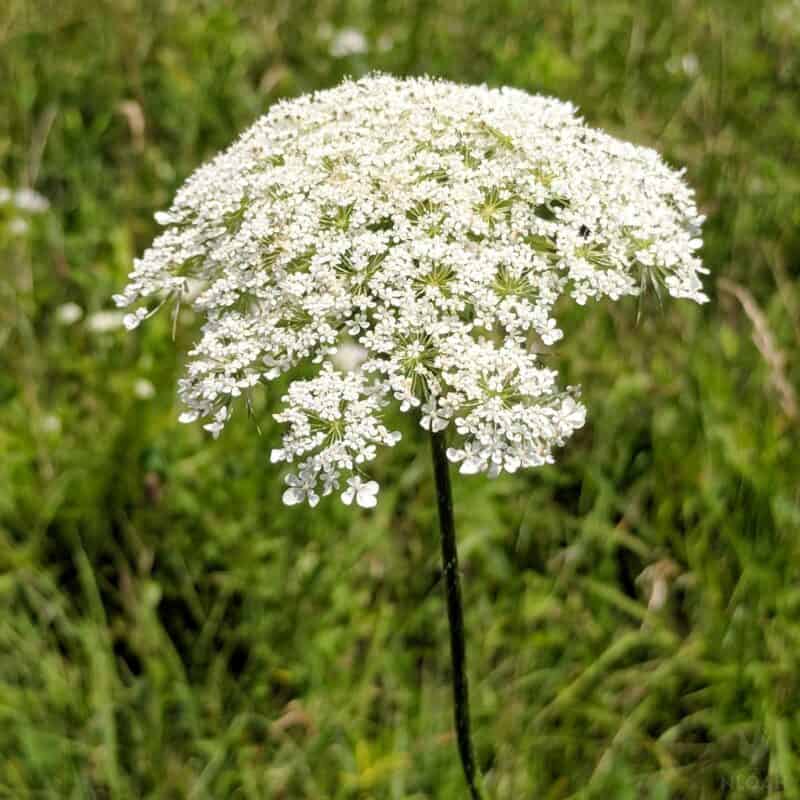
American colonists boiled the roots of Queen Anne’s lace and used them to make wine due to its incredibly high sugar content. The Irish and Hindus used wild carrots as a sweetener in many desserts, especially pudding.
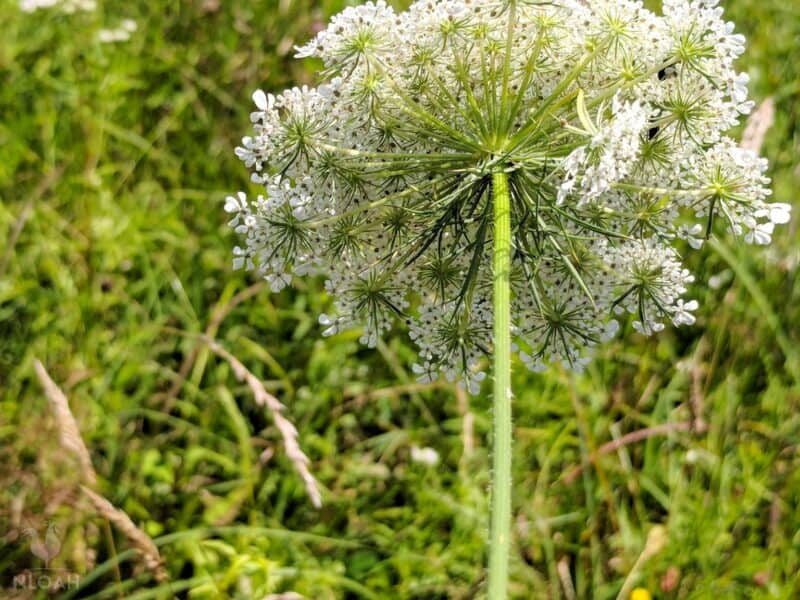
How To Identify Queen Anne’s Lace
- The flowers have a dainty and fragile lace style appearance.
- There is usually, but not always, a single little dot in the center of a wild carrot flower that is blue to purple in color.
- The flowers on wild carrots form a domed to flat-topped clustered appearance.
- If you turn a Queen Anne’s lace flower upside down it is umbrella-shaped.
- Wild carrots begin blooming in the final weeks of spring and continue in that state until the early fall.
- As it readies for blooming, the wild carrot flower moves from a curled-up state to fully open to pollinators.
- When blooming is over, the flower cluster will close up again, and look like a reversed umbrella once again.
- Fine white hairs dot the vibrant green stem of Queen Anne’s Lace flowers.
- The feathery leaves on wild carrots are not all that different than the one on garden carrots. The base of the leafstalks is both flat and broad.
- Typically, wild carrots can grow to be about three and a half feet tall.
- Queen Anne’s Lace is most often found in livestock pastures, fields, and along the side of the road.
- Unlike poison hemlock, wild carrots do not like a moist or shady environment. These edible weeds thrive in full sun and dry soil.
Yarrow
Achillea millefolium, or yarrow as it is more commonly known, is a member of the daisy family. The flowers on wild yarrow are white to a pale shade of yellow.
Wild yarrow is most commonly foraged and harvested for its medicinal value. One ancient legend claims Achilles used yarrow poultices to stop the bleeding of wounded soldiers during the battle with Troy.
How to Identify Yarrow
- Wild yarrow typically grows in dry soil, and prefers full sun like wild carrots.
- It typically grows between one to three feet tall.
- Blooming of wild yarrow begins in the final weeks of spring, and does not end until the middle of fall in most growing regions.
- Yarrow stems are fairly smooth, free of white fine hair like wild carrots, and do not have purple splotches like poison hemlock.
- While yarrow leaves do have somewhat of a feathery or fern-like appearance, they are not stiffer than leaves from the toxic weed.
- Crushed flowers and leaves from a wild yarrow plant will boast a spicy yet pleasant smell. Many folks have likened the scent of yarrow to that of common cooking herbs like rosemary and oregano.
Difference between yarrow and poison hemlock
The biggest difference is that yarrow is much shorter than poison hemlock, while poison hemlock has feather-like leaves.
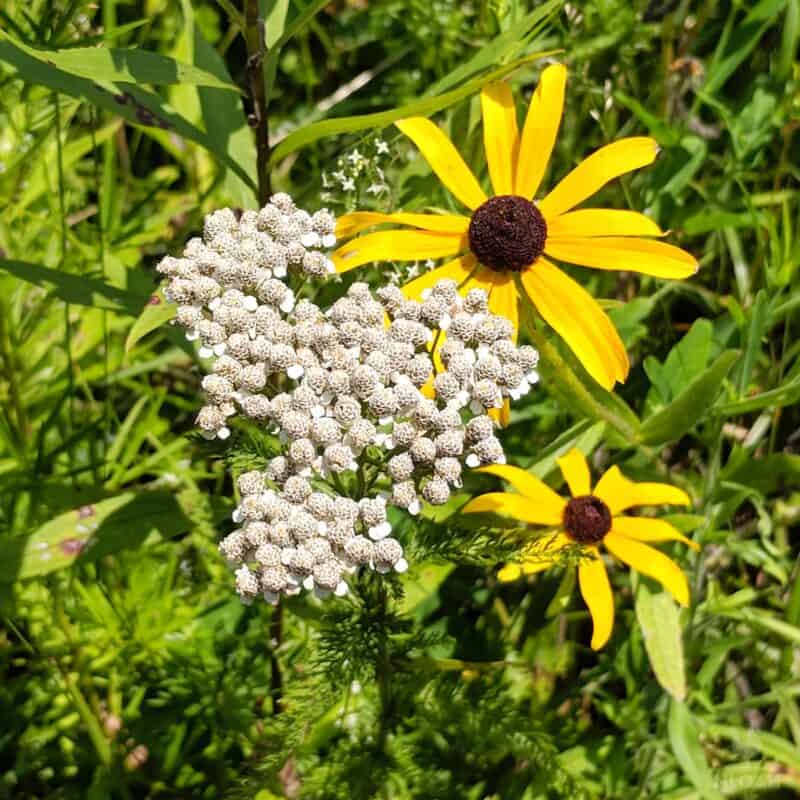
Some folks also become confused when searching for English daisies when foraging for wild carrots, yarrow, or attempting to avoid poison hemlock. English daisies could possibly resemble the toxic weed from a distance, but their stalks and leaves are entirely different.
The flowers on English daisies all have a solid yellow dot in the middle. Like wild carrots and yarrow, the little daisies prefer full sun, dry soil, and are often spotted in pastures and along the roadside.
Water Hemlock (Cicuta)
Yet another toxic lookalike is Cicuta maculata. See below:
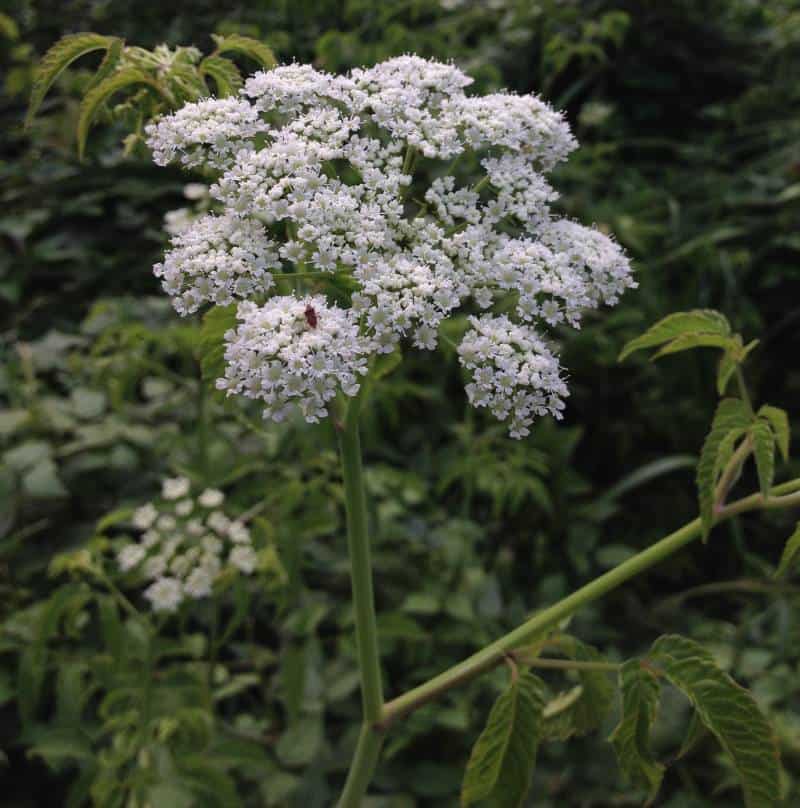
When in doubt, stay away from any plant that could possibly be poison hemlock. In some states, the department of natural resources, farm bureau, or 4-H extension office can offer guidance and perhaps removal assistance if you discover poison hemlock growing on your land.
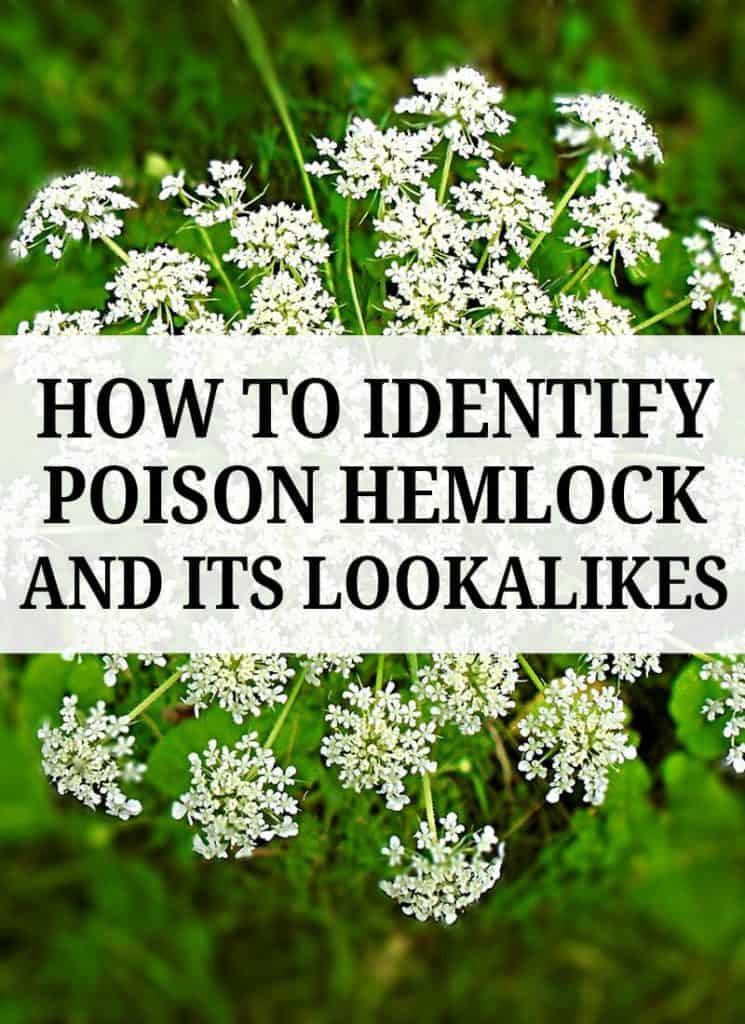

Tara lives on a 56 acres farm in the Appalachian Mountains, where she faces homesteading and farming challenges every single day, raising chickens, goats, horses, and tons of vegetables. She’s an expert in all sorts of homesteading skills such as hide tanning, doll making, tree tapping, and many more.

thank you. I found poison hemlock in my school garden and i thought it was yarrow
Thank you. I have poison hemlock under a cherry tree. I have been thinking of expanding the chicken’s pasture but it would include that tree. Thanks for the info.
Thank you, i had been thinking about these plants recently, but did not know how to tell them apart.